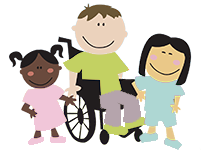What’s Eating Your Child? Feeding and Swallowing Disorders in Early Childhood
 Do you have a child who is struggling to eat? Are you concerned that your young child is not getting adequate nutrition or may be falling behind with physical growth?
Do you have a child who is struggling to eat? Are you concerned that your young child is not getting adequate nutrition or may be falling behind with physical growth?
It is a fact that good nutrition is critically important for overall development and it is wise to take note of your child’s eating patterns.http://medical.gerber.com/nutrition-health-topics/infant-early-childhood-nutrition/articles/early-childhood-nutrition-toddlers-to-preschoolers
For an infant or toddler, there are certain signs that may signal a swallowing disorder. Following are symptoms from ASHA (American Speech-Language-Hearing Association).
- arching or stiffening of the body during feeding
- irritability or lack of alertness during feeding
- refusing food or liquid
- failure to accept different textures of food (e.g., only pureed foods or crunchy cereals)
- long feeding times (e.g., more than 30 minutes)
- difficulty chewing
- difficulty breast feeding
- coughing or gagging during meals
- excessive drooling or food/liquid coming out of the mouth or nose
- difficulty coordinating breathing with eating and drinking
- increased stuffiness during meals
- gurgly, hoarse, or breathy voice quality
- frequent spitting up or vomiting
- recurring pneumonia or respiratory infections
- less than normal weight gain or growth
Difficulty with the feeding aspect of gathering food or liquids and getting it to the mouth would be referred to as a feeding disorder. A swallowing disorder would indicate that a child has difficulty getting ready to suck, chew, or swallow food or liquids.
Swallowing disorders, medically known as dysphagia (dis-FAY-juh), can take place in the oral phase, pharyngeal phase or esophageal phase of the swallowing process. ASHA defines these three phases as follows:
- Oral phase – sucking, chewing, and moving food or liquid into the throat
- Pharyngeal phase – starting the swallow, squeezing food down the throat, and closing off the airway to prevent food or liquid from entering the airway (aspiration) or to prevent choking
- Esophageal phase – relaxing and tightening the openings at the top and bottom of the feeding tube in the throat (esophagus) and squeezing food through the esophagus into the stomach
Many young children with sensory challenges or developmental differences will exhibit both feeding and swallowing disorders. They may not like to touch certain textures which is problematic since infants and toddlers start out finger feeding. Some young children have great difficulty with holding feeding utensils and cups. So these feeding deficits may need to be addressed with special strategies to build tolerance and enjoyment of particular textures, temperatures and tastes as well as with additional activities to improve fine motor skills.
Feeding and swallowing therapy is a specialized treatment, so a pediatric speech pathologist or occupational therapist obtains additional training in dysphagia. One model that is used frequently in our Clinics is the SOS (Sequential – Oral – Sensory) Approach to Feeding (Toomey/Ross). This model combines the “normal” developmental steps, stages and skills of feeding found in typically developing children. Feeding is a reflection of skill from the combined interaction of organs, muscles, senses, learning, development, nutritional status and environment. So if your child is a picky eater or problem feeder, it’s important to discover which of these systems are interfering with feeding development.
The SOS Approach to Feeding (Toomey/Ross), recommends that the following factors are assessed before solid foods are introduced to a child. These include:
- Physical readiness – is the child physically ready to eat? Does he need postural support? Can he hold his head up? Can he sit up by himself for 3-5 seconds?
- Physiological maturity to digest and breakdown more complex nutritional sources – how has your child responded to baby foods? Is he able to show tongue lateralization (movement of food by the tongue from one side of the mouth to the other)? Does your child show signs of reflux?
- Mental and motor development – has your child achieved motor milestones up to this point? For example, is he able to reach for a bottle or spoon when hungry? Is he showing hand-to-mouth play (indicating oral exploration of objects)?
- Impact of chronic disease- in looking are your child’s medical history, are there medical factors contributing to your child’s overall development? Was your child pre-term? Does he present with any developmental disabilities?
- Other social, psychological, cultural and economic considerations – does your child have a positive reaction to food? Does he gag when he sees food? What is your child’s stress level around food?
Feeding and swallowing therapy is designed to be a positive experience for your child, slowly introducing new textures and foods into the diet. Family training is an important aspect of treatment since you, as the parent will be with your child through out the normal eating times of the day.
If you find that your child struggles across some of these areas, you may need to consider feeding and swallowing therapy. At Speech & Occupational Therapy of North Texas, a licensed speech-language pathologist can holistically look at your child and evaluate the feeding, motor and sensory skills required to eat.
